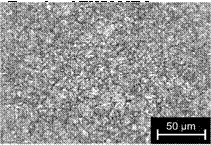Tool steels are generally subdivided into
• unalloyed tool steels and
• alloyed tool steels.
These are utilised for varied purposes. Therefore tool steels are further differentiated into the particular application groupings of cold working steels, hot working steels and high speed steels. The assignment of any steel to a tool steel group results only from a consideration of its practical purpose. Differentiation from other steel groups based on their alloy compositions is impossible, since chemical composition varies broadly (table 4-6), and manufacture influences their properties. Essentially, the distinguishing characteristics of these three subgroups are the obtainable hardness and the path of hardness as a function of the annealing temperature.
|
Table 4-6. Possible compositions of tool steels [N. N.98]
|
In a hardened state, the structure of tool steels consists of surface layers primarily made of martensite, which gradually changes into bainite and fine lamellar pearlite towards the inner workpiece. In the case of supereutectoid steels, cemen — tite grains are embedded in the matrix as well, if the steel was in a spheroidised state prior to hardening. Should this pre-treatment be left out, then remnants of the brittle cementite network take the place of the cementite grains.
Selecting alloying additives for tool steels is based first and foremost on their influence on surface hardness, hardness depth, tempering stability, toughness and wear resistance, whereby a suitable coordination with the carbon content is necessary, especially for higher-alloyed steels. The carbon content of the steel determines the amount of wear-resistant carbides in the structure and is thus an essential factor in wear resistance.
Carbon also influences hardenability and contributes decisively to tempering stability and toughness via carbide reactions during hardening and tempering.
Cold-working steels (Fig. 4-10, left) have a high initial hardness, which falls rapidly with increasing temperature above 200 °C. They are used primarily at room or slightly higher temperatures for shaping materials into cutting, cold forming and plastic forming tools.
Hot-working steels (Fig. 4-10, right), on the other hand, have a significantly lower initial hardness, which, however, remains constant at annealing temperatures up to almost 600 °C. They are used for non-cutting metal forming at high
temperatures, e. g. to shape die casts as well as the dies and hammers of forging machines.
 |
 |
High-speed steels have both a high initial hardness and hardness stability up to high temperatures and are applied mainly in cutting tools as well as in forming and finishing tools. With respect to their compositions, high-speed steels are high — alloyed special steels on the basis of chrome, tungsten, molybdenum and vanadium with carbon contents over 0.7 %. They exhibit a large amount of carbides [N. N.98]
